博文
[Science]胚与胚乳之间的分子双向交流在种子发育过程中必不可少(1)
|||
A two-way molecular dialogue between embryo and endosperm is required for seed development
Author: N. M. Doll, S. Royek, S. Fujita, et al.
Corresponding author: G. Ingram.
Affiliations: Laboratoire Reproduction et Développement des Plantes, University of Lyon, ENS de Lyon, UCB Lyon 1, CNRS, INRAE, F-69342, Lyon, France, et al.
第一次非常细致地阅读这么高水平的文章,啃起来非常慢,但是真心感觉到学到了很多东西,也真心感受到与别人科研水平的差距。以下是自己对文章的翻译以及内容理解、整理,这篇博文内容包括文章的summary以及前面1/3的部分。本人才疏学浅,只为做一个记录,如有错处,希望能和大家一起理性讨论学习~
The plant embryonic cuticle is a hydrophobic barrier deposited de novo by the embryo during seed
development. At germination, it protects the seedling from water loss and is, thus, critical for
survival. Embryonic cuticle formation is controlled by a signaling pathway involving the ABNORMAL
LEAF SHAPE1 subtilase and the two GASSHO receptor-like kinases. We show that a sulfated peptide,
TWISTED SEED1 (TWS1), acts as a GASSHO ligand. Cuticle surveillance depends on the action of the
subtilase, which, unlike the TWS1 precursor and the GASSHO receptors, is not produced in the embryo
but in the neighboring endosperm. Subtilase-mediated processing of the embryo-derived TWS1
precursor releases the active peptide, triggering GASSHO-dependent cuticle reinforcement in the
embryo. Thus, a bidirectional molecular dialogue between embryo and endosperm safeguards cuticle
integrity before germination.
植物种子中的胚表皮是天然的疏水屏障,在种子的发育过程中对胚胎起到保护作用。种子发芽过程中,表皮保护幼苗不受缺水的影响,对植株生存至关重要。胚胎表皮的构成是由一个信号传导路径控制的,这个路径包括一个“异常叶表皮”枯草杆菌蛋白酶(ALS1)以及两个类受体激酶(GSO1/GSO2)。作者在研究过程中发现了一个硫酸化的多肽TWS1(“种子扭曲”),作为GSO的配体发挥作用。表皮的发生监控取决于枯草杆菌蛋白酶ALS1,它并不像前提TWS1以及受体GSO一样在胚中产生,而是在与胚邻近的胚乳中产生。枯草杆菌蛋白酶调控的前体TWS1(源于胚胎)释放出活性多肽,启动了GSO决定的胚胎表皮坚固的进程。总而言之,在胚与胚乳之间的这样一个双向分子交流使得胚胎表皮在种子发芽前更加坚固。
In angiosperms, seeds comprise three genetically distinct compartments: the zygotic
embryo, the endosperm, and the maternal
seed coat. Their development must be
tightly coordinated for seed viability. In
this work, we have elucidated a bidirectional
peptide-mediated signaling pathway between
the embryo and the endosperm. This pathway
regulates the deposition of the embryonic cuticle, which forms an essential hydrophobic
barrier separating the apoplasts of the embryo
and endosperm. After germination, the cuticle—
one of the critical innovations underlying the
transition of plants from their original, aqueous
environment to dry land—protects the seedling
from catastrophic water loss.
在被子植物中,种子常常由三个部分组成:合子胚,胚乳以及来自母本的种皮。这三者的生长发育紧密相关从而为种子的生存提供保障。在本文的研究中,我们阐述了一个胚与胚乳之间的多肽参与调控的双向信号交流路径。这条路径调控了胚胎表皮的沉积活动,而正是表皮形成了非常重要的疏水屏障来保护胚胎。在种子发芽之后,正是表皮这一奇妙的结构,保护植物在从原生的水分充足的环境到干燥的大地环境的这一过程中,免遭缺水的灾祸。
Formation of the embryonic cuticle has previously been shown to depend on two receptorlike kinases (RLKs)—GASSHO1/SCHENGEN3
(hereafter named GSO1) and GSO2—and on
ALE1, a protease of the subtilase family (2–5).
gso1 gso2 and (to a lesser extent) ale1 mutants
produce a patchy and highly permeable cuticle
(2). Mutant embryos also adhere to surrounding tissues, causing a seed-twisting phenotype
(6). Because subtilases have been implicated in
the processing of peptide hormone precursors
(7–9), we hypothesized that ALE1 may be required for the biogenesis of the elusive intercompartmental peptide signal required for
GSO1/2-dependent cuticle deposition.
研究表明,胚胎表皮的形成是由两个类受体激酶(Receptor Like Kinase, RLK)GSO1/2以及枯草杆菌家族中的蛋白酶ALE1。前人研究发现,gso1/gso2的双突以及ale1单突突变体植株生成的胚表皮并不完整而且还会有高渗透性问题的现象。突变体的胚胎还会和周围的组织粘附在一起,形成一种特别的“种子扭曲(seed-twisting)”表型。由于枯草杆菌蛋白酶已经被证实会参与多肽激素的前体合成,所以我们假设:由GSO决定的表皮沉积过程中需要ALE1来参与这一直未知的各组分间的多肽信号生成。
CASPARIAN STRIP INTEGRITY FACTORs
(CIFs), a family of small sulfated signaling peptides, are ligands for GSO1 and GSO2 (10–12).
CIF1 and CIF2 are involved in Casparian strip
formation in the root endodermis (10, 11). The
function of CIF3 and CIF4 is still unknown.
To assess the role of CIF peptides in cuticle
development, the quadruple mutant (cif1 cif2
cif3 cif4) was generated (fig. S1A).
研究表明,凯氏带完整因子(Casparian Strip Integrity Factor, CIF)是一个小型硫酸化信号多肽家族,充当GSO1/2的配体(ligand)。CIF1/2参与了根部内皮层的凯氏带形成过程。CIF3/4的作用目前仍未知。为了搞清楚CIF多肽在胚表皮生成中所发挥的作用,我们获得了四突(cif1/cif2/cif3/cif4)的突变体材料。见下图。cif1/2/4分别插入了一个碱基,而cif3丢失了一个碱基。
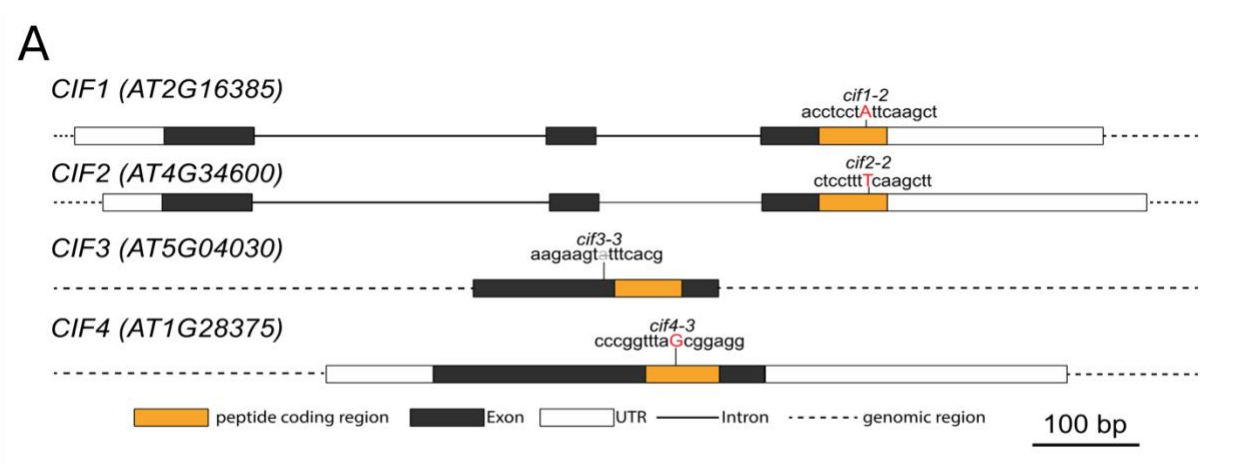
Neither cuticle permeability nor seed twisting phenotypes were observed in this quadruple mutant (fig. S1, B to E).
对突变体的表型观察发现,没有出现表皮渗透性(permeability)问题,也没有种子扭曲的现象。见下图。BC分别为野生型与突变体的成熟干燥的种子,DE分别是对野生型与突变体的子叶进行甲苯胺蓝染色观察表皮的完整性。
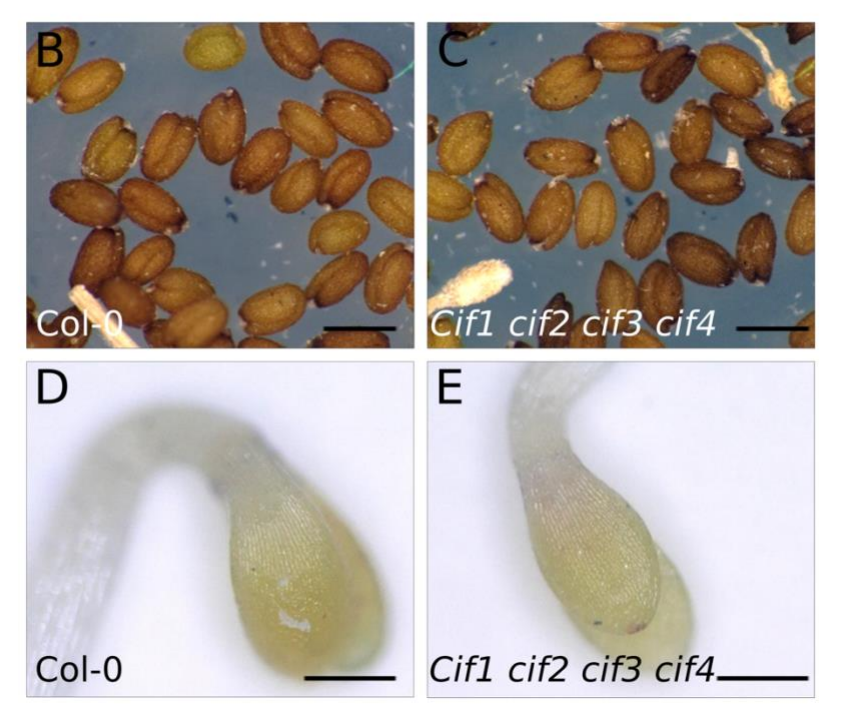
However, reduction [in the leaky sgn2-1 allele (10)] or loss [in the tpst-1 mutant (13)] of tyrosyl-protein sulfotransferase (TPST) activity results in seed-twisting and cuticlepermeability phenotypes resembling those observed in ale1 mutants (Fig. 1, A to D, and fig. S2, A to D).
研究表明,酪氨酰蛋白磺基转移酶(Tyrosyl-Protein Sulfotransferase, TPST)(博主注:TPST是一种催化酪氨酸硫酸化的酶)的活性降低便会导致种子扭曲以及高渗的表型(tpst-1及sgn2突变体),这恰恰与ale1突变体的表型很相似。见下图。上图中A-C为对各突变体与野生型的子叶甲苯胺蓝染色观察,D为对各植株材料的幼苗地上部分的定量甲苯胺蓝测试,以叶绿素含量作为衡量因素;下图中A-C为各突变体成熟种子,星号为有“种子扭曲”表型的畸形种子,D为畸形种子率。
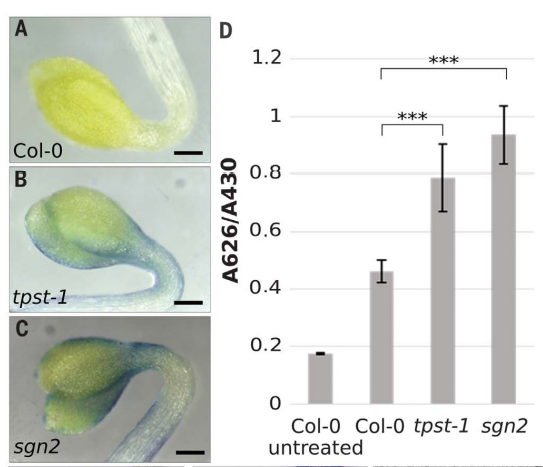

These data suggest that a sulfated peptide may act as the ligand of GSO1/2 during seed development.
这些结果说明,硫酸化的多肽或许是作为GSO1/2的配体来影响种子发育。
Consistent with the hypothesis that TPST acts in the same pathway as GSO1 and GSO2, no difference was observed between the phenotype of tpst-1 gso1-1 gso2-1 triple and gso1-1 gso2-1 double mutants (fig. S2E).
与之前的假设一样,TPST与GSO参与了同样的路径,表型观察中,tpst-1/gso1/gso2的三突及gso1/gso2双突的表型没有任何区别。见下图。
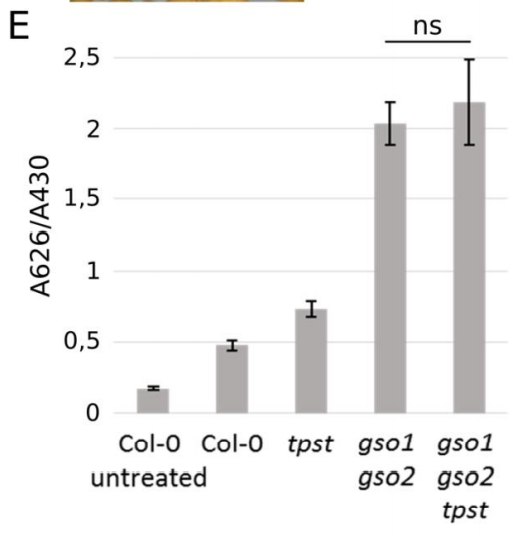
In contrast, TPST and ALE1 appear to act synergistically, as a phenotype resembling that of gso1 gso2 double mutants was observed in tpst-1 ale1-4 double mutants (Fig. 1, E to I, and fig. S2, F to J).
相对地,TPST却和ALE1是协同作用,因为gso1/gso2双突与tpst-1/ale1双突的表型是相似的。见下图。



This result supports the hypothesis that TPST
and ALE1 act in parallel regarding their roles
in embryonic cuticle formation, possibly through
independent posttranslational modifications
that contribute to the maturation of the hypothetical peptide signal.
这些结果支持了之前的假设——TPST和ALE1在胚胎表皮形成机制中的作用是并列的,很有可能是参与了不同的蛋白翻译后修饰活动,从而作用于种子成熟过程中可能存在的多肽信号传递。
[博主注:蛋白的翻译后修饰(Post-Translational Modifications,PTM),又称后翻译修饰,是指蛋白质在翻译之后进行的化学修饰,蛋白质在翻译后会给多肽附着上其它的生物化学官能团从而改变其化学性质,或者造成结构变化,从而扩充蛋白质的功能。这可以让蛋白质活化或钝化。]
Identification of the peptide signal was facilitated by a study of TWISTED SEED1 (TWS1) (14), which reported a loss-of-function phenotype that was notably similar to that of gso1 gso2 double mutants. Because existing alleles of TWS1 are in the Wassilewskija (WS) background, we generated new CRISPR alleles (tws1-3 to tws1-10) in the Col-0 background and confirmed the phenotype of resulting mutants (Fig. 1 and fig. S3).
关于多肽信号的工作在对tws1(twisted seed1)的研究后得到了进展,tws1的突变体产生了与gso1/2双突突变体高度相似的功能缺失(loss-of-function)表型。因为Wassilewskija(WS)背景下存在TWS1的等位基因,我们利用CRISPR获得了tws1的各个突变体(tws1-3至tws1-10),并且确认了这些突变体的表型。见下图。AB为突变体DNA序列,C为预测的蛋白序列。
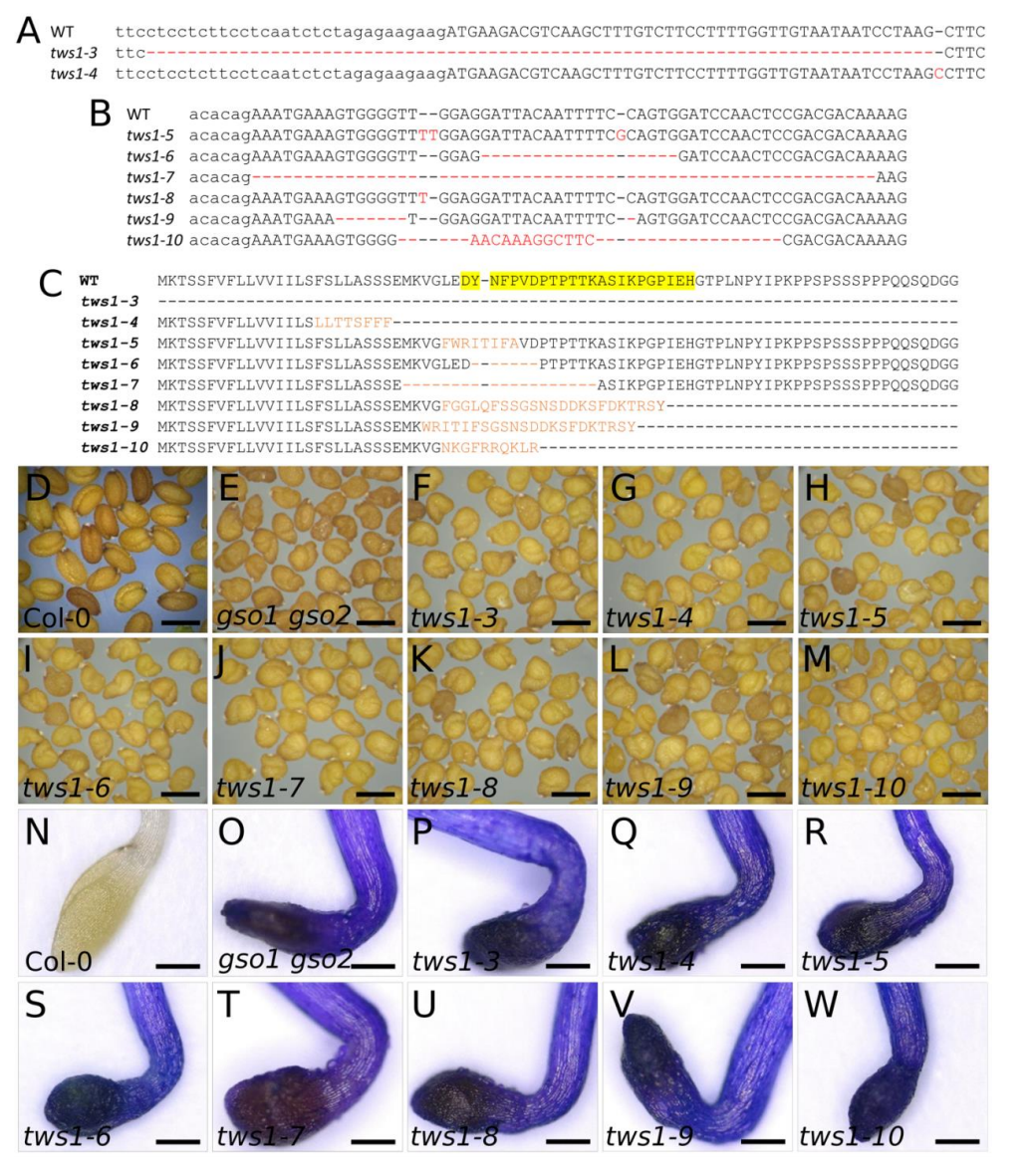
No additivity was observed when loss-of-function alleles of TWS1 and of other pathway components (GSO1, GSO2, TPST, and ALE1) were combined, providing genetic evidence for TWS1 acting in the GSO signaling pathway (fig. S4).
对tws1的各种突变体(包括GSO通路上的各类组分的共突变体)的表型观察发现,它们通通都没有显著的差异。这说明TWS1是在GSO通路上工作的。见下图。

Furthermore, gaps in the cuticle of embryos and cotyledons, similar to those observed in ale1 and gso1 gso2 mutants (2), were detected in both the tws1 mutants and tpst mutants (Fig. 1, J to N, and fig. S5).
前人研究表明,在ale1单突以及gso1/2双突突变体中,胚与子叶的表皮存在孔洞。而在我们的研究中,tws1以及tpst的突变体也有同样的表型特征。见下图。end-endosperm胚乳,emb-embryo胚,cut-cuticle表皮。上图L-N及下图G-L均为对胚/胚乳交界处的透射电镜(Transmission Electron Microscopy, TEM)观察,下图A-F为对幼苗分层(stratification)3天后的子叶表皮的金胺O染色观察。

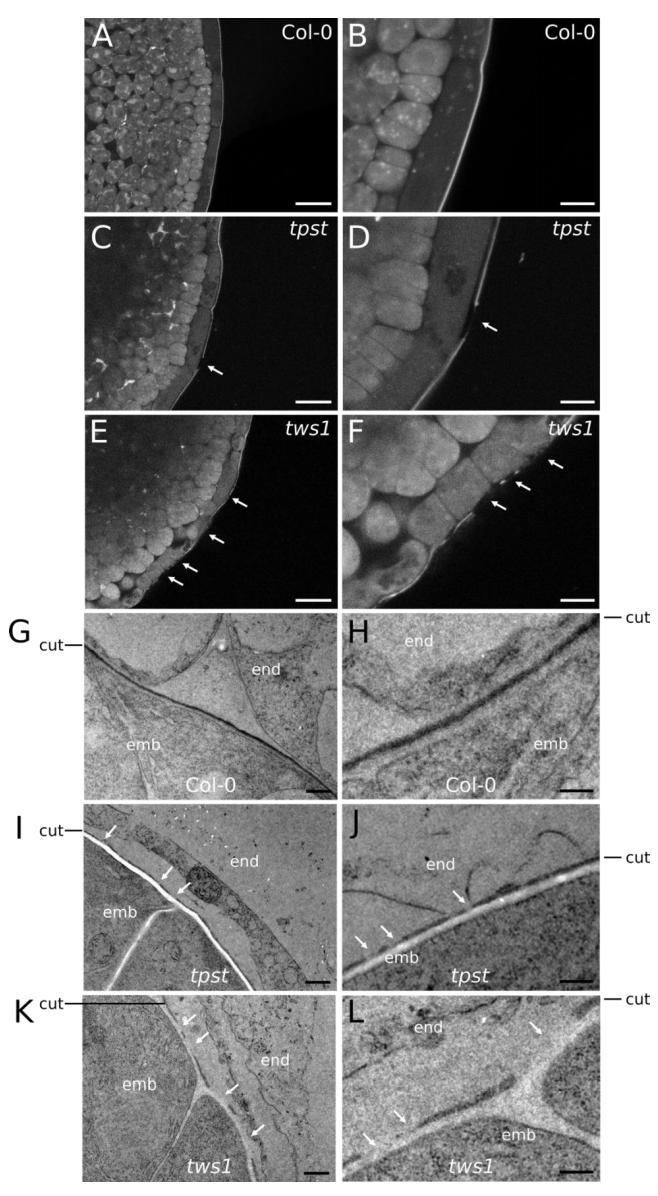
Inspection of the TWS1 protein sequence revealed a region with limited similarity to CIF peptides, including a DY motif that marks the N terminus of the CIFs (Fig. 1O) and is the minimal motif required for tyrosine sulfation by TPST (15).
对TWS1蛋白序列的检测发现了一个与CIF蛋白(GSO的配体)具有限制性相似的区域,包括一个DY基序(DY motif)以及N终端,这正是TPST的酪氨酸硫酸化所需要的的最小基序。见下图。标红星意为预测的可能发生硫酸化的区域。
(博主注:A motif is a similar 3-D structure conserved among different proteins that serves a similar function.)
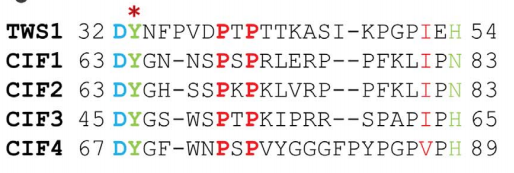
Corroborating the functional importance of the putative
peptide domain, the tws1-6 allele (deletion of
six codons in the putative peptide-encoding
region) and the tws1-5 allele (substitution of
eight amino acids, including the DY motif) both
showed total loss of function of the TWS1 protein (fig. S3).
tws1-6突变体(编码区缺失6个密码子)以及tws1-5突变体(发生了8个氨基酸的替换,包括DY基序)都表现出TWS1蛋白的完全的功能缺失。见前面tws1各种突变体的表型观察图。
[TO BE CONTINUED]
附件为文章pdf原文以及supplementary materials,供大家一起交流学习~
A two-way molecular dialogue between embryo and endosperm is required for seed d.pdf
https://blog.sciencenet.cn/blog-3449010-1254905.html
上一篇:[the Plant Journal] DLC1基因编码了B类反应调控因子并且在水稻的减数分裂中起到关键作用
下一篇:[Science]胚与胚乳之间的分子双向交流在种子发育过程中必不可少(2)